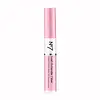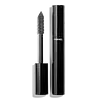What's inside
What's inside
 Key Ingredients
Key Ingredients

 Benefits
Benefits

 Concerns
Concerns

 Ingredients Side-by-side
Ingredients Side-by-side

Water
Skin ConditioningEuphorbia Cerifera Wax
Euphorbia Cerifera Cera
AstringentAcacia Senegal Gum
MaskingSynthetic Wax
AbrasivePolybutene
Pvp
Emulsion StabilisingCopernicia Cerifera Wax
Arginine
MaskingPalmitic Acid
EmollientStearic Acid
CleansingButylene Glycol
HumectantGlyceryl Stearate
EmollientRhus Verniciflua Peel Wax
Cellulose
AbsorbentPhenoxyethanol
PreservativeCaprylyl Glycol
EmollientHydroxyethylcellulose
Emulsion StabilisingPotassium Sorbate
PreservativeAscorbyl Palmitate
AntioxidantTocopherol
AntioxidantPentylene Glycol
Skin ConditioningC10-18 Triglycerides
EmollientPyrus Malus Fruit Extract
Skin ConditioningTartaric Acid
BufferingCitric Acid
BufferingCitrus Limon Fruit Extract
MaskingTriticum Vulgare Bran Extract
Skin ConditioningVitis Vinifera Fruit Extract
Skin ConditioningPlankton Extract
Skin ConditioningDisodium Phosphate
BufferingPolysorbate 60
EmulsifyingSodium Phosphate
BufferingSodium Benzoate
MaskingCI 77499
Cosmetic ColorantWater, Euphorbia Cerifera Wax, Euphorbia Cerifera Cera, Acacia Senegal Gum, Synthetic Wax, Polybutene, Pvp, Copernicia Cerifera Wax, Arginine, Palmitic Acid, Stearic Acid, Butylene Glycol, Glyceryl Stearate, Rhus Verniciflua Peel Wax, Cellulose, Phenoxyethanol, Caprylyl Glycol, Hydroxyethylcellulose, Potassium Sorbate, Ascorbyl Palmitate, Tocopherol, Pentylene Glycol, C10-18 Triglycerides, Pyrus Malus Fruit Extract, Tartaric Acid, Citric Acid, Citrus Limon Fruit Extract, Triticum Vulgare Bran Extract, Vitis Vinifera Fruit Extract, Plankton Extract, Disodium Phosphate, Polysorbate 60, Sodium Phosphate, Sodium Benzoate, CI 77499
Water
Skin ConditioningCera Alba
EmollientSynthetic Wax
AbrasiveAcacia Senegal Gum
MaskingPalmitic Acid
EmollientGlyceryl Stearate
EmollientStearic Acid
CleansingButylene Glycol
HumectantCopernicia Cerifera Wax
Polybutene
Vp/Eicosene Copolymer
Aminomethyl Propanediol
BufferingHydroxyethylcellulose
Emulsion StabilisingPotassium Sorbate
PreservativeChlorphenesin
AntimicrobialCaprylyl Glycol
EmollientEthylhexylglycerin
Skin ConditioningAscorbyl Palmitate
AntioxidantTocopherol
AntioxidantCI 75470
Cosmetic ColorantCI 77000
Cosmetic ColorantCI 77007
Cosmetic ColorantCI 77163
Cosmetic ColorantCI 77288
Cosmetic ColorantCI 77491
Cosmetic ColorantCI 77492
Cosmetic ColorantCI 77499
Cosmetic ColorantCI 77510
Cosmetic ColorantCI 77742
Cosmetic ColorantCI 77891
Cosmetic ColorantMica
Cosmetic ColorantWater, Cera Alba, Synthetic Wax, Acacia Senegal Gum, Palmitic Acid, Glyceryl Stearate, Stearic Acid, Butylene Glycol, Copernicia Cerifera Wax, Polybutene, Vp/Eicosene Copolymer, Aminomethyl Propanediol, Hydroxyethylcellulose, Potassium Sorbate, Chlorphenesin, Caprylyl Glycol, Ethylhexylglycerin, Ascorbyl Palmitate, Tocopherol, CI 75470, CI 77000, CI 77007, CI 77163, CI 77288, CI 77491, CI 77492, CI 77499, CI 77510, CI 77742, CI 77891, Mica
Ingredients Explained
These ingredients are found in both products.
Ingredients higher up in an ingredient list are typically present in a larger amount.
Acacia Senegal Gum has skin soothing, thickening, and formulation stabilizing properties. It comes from the Acacia tree that is native to sub-Saharan Africa.
Ascorbyl Palmitate is created by combining pure Vitamin C and palmitic acid. It is an antioxidant and helps reduce hyperpigmentation.
This ingredient is a more stable version of Vitamin C, meaning it does not disintegrate as quickly when exposed to sunlight. However, studies show it does not penetrate skin as well as pure Vitamin C.
Ascorbyl Palmitate is oil soluble.
Read more about other types of Vitamin C:
Learn more about Ascorbyl PalmitateButylene Glycol (or BG) is used within cosmetic products for a few different reasons:
Overall, Butylene Glycol is a safe and well-rounded ingredient that works well with other ingredients.
Though this ingredient works well with most skin types, some people with sensitive skin may experience a reaction such as allergic rashes, closed comedones, or itchiness.
Learn more about Butylene GlycolCaprylyl Glycol is a humectant and emollient, meaning it attracts and preserves moisture.
It is a common ingredient in many products, especially those designed to hydrate skin. The primary benefits are retaining moisture, skin softening, and promoting a healthy skin barrier.
Though Caprylyl Glycol is an alcohol derived from fatty acids, it is not the kind that can dry out skin.
This ingredient is also used as a preservative to extend the life of products. It has slight antimicrobial properties.
Learn more about Caprylyl GlycolCi 77499 is also hydrated iron III oxide. It is created from mixing red and black iron oxides. This helps give shades of darkness to a product.
Iron III oxides are classified as inorganic chemicals for coloring.
Copernicia Cerifera Wax comes from a palm tree native to Brazil; another name for this ingredient is Carnauba Wax.
This ingredient is used to thicken texture and also leaves behind a film when applied.
Fun fact: This wax has the highest melting point of all natural waxes and low solubility.
Learn more about Copernicia Cerifera WaxGlyceryl Stearate is a mix of glycerin and stearic acid.
It is used to stabilize the mixing of water and oil ingredients. By preventing these ingredients from separating, it can help elongate shelf life. It can also help thicken the product's texture.
As an emollient, it helps soften skin and supports barrier-replenishing ingredients.
In cosmetics, Glyceryl Stearate is often made from vegetable oils or synthetically produced.
This ingredient may not be fungal-acne safe
Fun fact: The human body also creates Glyceryl Stearate naturally.
Learn more about Glyceryl StearateHydroxyethylcellulose is used to improve the texture of products. It is created from a chemical reaction involving ethylene oxide and alkali-cellulose. Cellulose is a sugar found in plant cell walls and help give plants structure.
This ingredient helps stabilize products by preventing ingredients from separating. It can also help thicken the texture of a product.
This ingredient can also be found in pill medicines to help our bodies digest other ingredients.
Learn more about HydroxyethylcellulosePalmitic Acid is a fatty acid naturally found in our skin and in many plant and animal sources. In cosmetics, it is usually derived from palm oil. It serves many purposes in skincare, acting as a cleanser, emollient, and emulsifier.
As an emollient, palmitic acid helps soften and smooth the skin by preventing water loss. In cleansers, it helps remove oil and dirt while creating foam.
Its emulsifying properties help stabilize products by keeping water and oil-based ingredients from separating.
This may not be suitable for fungal acne-prone skin, as fatty acids like this can sometimes trigger breakouts in sensitive individuals.
Learn more about Palmitic AcidPolybutene is used to help control the viscosity of a product. This just means it helps adjusts the texture.
It is a polymer and does not get absorbed into the skin due to its large size.
Studies found this ingredient did not irritate skin in concentrations below 15%.
Learn more about PolybutenePotassium Sorbate is a preservative used to prevent yeast and mold in products. It is commonly found in both cosmetic and food products.
This ingredient comes from potassium salt derived from sorbic acid. Sorbic acid is a natural antibiotic and effective against fungus.
Both potassium sorbate and sorbic acid can be found in baked goods, cheeses, dried meats, dried fruit, ice cream, pickles, wine, yogurt, and more.
You'll often find this ingredient used with other preservatives.
Learn more about Potassium SorbateStearic Acid is a fatty acid. It is an emollient, emulsifier, and texture enhancer.
As an emollient, stearic acid helps soften skin. It aids the skin's protective barrier by preventing water loss. It also provides a gentle cleansing effect without stripping away natural oils.
Stearic acid may also be used to enhance the texture of products. It can add volume and stabilize ingredients such as water and oil. This can help water and oil ingredients from separating.
Sources of stearic acid include animal or vegetable fats/oils such as coconut or shea. It can be naturally found in butter, cocoa butter, shea butter, vegetable fats, and animal tallow.
This ingredient may not be Malassezia folliculitis, or fungal-acne safe.
Learn more about Stearic AcidSynthetic Wax is created from fossil fuels such as natural gas. It is used to enhance texture, adjust pH, and as an occlusive.
It may also be used as an abrasive ingredient to exfoliate the skin.
Synthetic Wax may not be fungal acne safe.
Learn more about Synthetic WaxTocopherol (also known as Vitamin E) is a common antioxidant used to help protect the skin from free-radicals and strengthen the skin barrier. It's also fat soluble - this means our skin is great at absorbing it.
Vitamin E also helps keep your natural skin lipids healthy. Your lipid skin barrier naturally consists of lipids, ceramides, and fatty acids. Vitamin E offers extra protection for your skin’s lipid barrier, keeping your skin healthy and nourished.
Another benefit is a bit of UV protection. Vitamin E helps reduce the damage caused by UVB rays. (It should not replace your sunscreen). Combining it with Vitamin C can decrease sunburned cells and hyperpigmentation after UV exposure.
You might have noticed Vitamin E + C often paired together. This is because it is great at stabilizing Vitamin C. Using the two together helps increase the effectiveness of both ingredients.
There are often claims that Vitamin E can reduce/prevent scarring, but these claims haven't been confirmed by scientific research.
Learn more about TocopherolWater. It's the most common cosmetic ingredient of all. You'll usually see it at the top of ingredient lists, meaning that it makes up the largest part of the product.
So why is it so popular? Water most often acts as a solvent - this means that it helps dissolve other ingredients into the formulation.
You'll also recognize water as that liquid we all need to stay alive. If you see this, drink a glass of water. Stay hydrated!
Learn more about Water